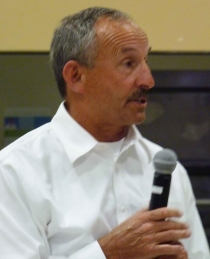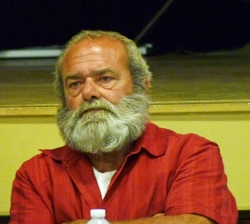"What about the complete loss of our lifestyle?" - Linda Hayes, Lakeside rancher


August 5, 2011 (Lakeside) – Mark Weston, General Manager, and Carlos Lugo, chief engineer for Helix Water District fielded heated questions at a Lakeside Planning Group meeting Wednesday night over the District's proposed El Monte Valley Mining, Reclamation, and Groundwater Recharge project.
Helix has submitted an environmental impact report to the County for a major use permit, though the report is not yet available to the public. “First review will take no less than 45 days,” Lugos said. The entire EIR process could take a couple of years.
The project would provide purified, recycled water that has gone through standard tertiary treatment pus additional microfiltration, 100 percent reverse osmosis, hydrogen peroxide, and ultraviolet treatment. Ultimately the project would provide 15% of the District’s water supplies, providing an important local water source to reduce dependence on diminishing water supplies from the Colorado River and Northern California. San mining would produce revenues to help offset costs of the project, if approved.
But planners seemed less than enthusiastic about the prospect of sand mining in the valley.
Planning group member Tom Medvitz opined that “Looks like this project may not be built…the EIR may squelch it and bring it to a screeching halt.”
Wyatt Allen Junior, another member, asked, “I really wish you guys would consider not mining that sand….Leave the valley looking like it is and don’t harm it.”
 Member Chad Enniss went further. “I’m thinking of filing suit against the County for dereliction of duty under the Surface Mining Act.” He said the District was “dreaming” if it thought it could complete mining operations in the ten years the District has predicted. “They’ll be there for 30 years.” Enniss owns a contracting business that includes "sand materials" on his website, an issue that may raise conflict of interest issues for him down the road.
Member Chad Enniss went further. “I’m thinking of filing suit against the County for dereliction of duty under the Surface Mining Act.” He said the District was “dreaming” if it thought it could complete mining operations in the ten years the District has predicted. “They’ll be there for 30 years.” Enniss owns a contracting business that includes "sand materials" on his website, an issue that may raise conflict of interest issues for him down the road.
Robin Clegg, another planner, asked about the reason for sand mining. “Is that so all of your salaries can go up?” Weston responded that the money made of sand mining would “go into the project fund.”
Members of the public also raised questions. Some voiced concerns over the impact of dredging on flood control. “In 1979 El Capitan dam overflowed,” one audience member noted, adding that last year Mission Valley including the stadium flooded when the San Diego River overflowed its banks. “What’s gonnna happen when you channel that valley?”
Weston offered assurances that the project was engineered to avoid flooding and control spills and said dredging the top 10 feet of sand in El Monte Valley would “have no effect on what happens in Mission Valley.” Sand in El Monte Valley is 200 feet deep in places, he added.
A spokeswoman from the Lakeside Revitalization Group invited Weston to attend a meeting to focus on creation a “positive vision of what do we want to see in the valley,” adding, “You already know what we don’t want to see.”
For residents of the El Monte Valley, the Helix project comes on the heels of SDG&E’s Sunrise Powerlink construction, a project that has drawn outrage for despoiling a designated county scenic view corridor and increasing fire danger in a valley where some of the region’s most deadly wildfires have already taken a severe toll.
Helix officials, to their credit, have been willing to meet with residents repeatedly and attempt to hammer out solutions, unlike SDG&E, which bypassed the customary approval process , met just once with residents, and then cancelled all future meetings.
Linda Hayes, a ranch owner whose well water may be adversely impacted, voiced concerns over the broader changes she fears will destroy her way of life. “What about the impacts on property values, traffic jams? There’s only one way out of this valley. What about the complete loss of our lifestyle? Is this being considered?” she asked.
Weston noted that the public has a right to challenge the EIR, including through litigation if concerns are not resolved.
Responding to a questioner who asked why not put the treated water directly into Lake Jennings Reservoir, Weston said that a new report will include that option.
The Helix Water district general manager also left the door open for the possibility that the mining portion of the project might be tossed out. “We’re looking at it with and without sand mining, because it’s more important to us as a water project,” Weston disclosed.
He did not address how the district might fund the project without the sand mining however. Helix board members have already come under fire for proposing new water rate hikes to consumers. While some benefits to district employees have been trimmed, customers ired over rising water rates have called on the district to further cut its expenses—a prospect that that would be made more challenging if sand mining were removed from the El Monte Valley project.










Recent comments